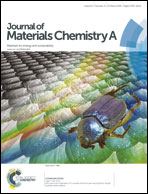New insights into the electrochemical performance of Li2MnSiO4: effect of cationic substitutions†
Abstract
The performance of the Li2MnSiO4 cathode material is hindered by voltage decay and capacity fading caused by structural instability. To rationalize the origin of such structural instability, we have investigated a total of 142 Li2yMnSiO4 configurations at y = 0.125, 0.25, 0.333, 0.375, 0.417, 0.5, 0.625, 0.666, 0.75 and 0.875 by density functional theory methods. It is found that the most stable Li2yMnSiO4 configurations with y ≤ 0.5 consist of Mn4+ and Mn3+ in octahedral or five-fold coordination. This induces a crystal deformation, loss of the orthogonal symmetry, and a notorious volume decrease (7% for LiMnSiO4 and 14% for Li0.5MnSiO4). The effect of Mn substitution on the crystal structure of the delithiated silicates Li0.5Mn0.75M0.25SiO4 is computationally investigated for M = Mg, Fe, Co and Ni. The most stable configurations for Mg, Fe and Co substitutes possess Mn4+ in octahedral coordination, sharing edges with the adjacent Si and Mn polyhedra. DFT results suggest that among the studied substituents, only Ni could help to maintain the structural integrity of the delithiated samples. Experimentally, Li2Mn1−xNixSiO4 samples with x = 0, 0.1 and 0.2 were synthesized and electrochemically tested.


 Please wait while we load your content...
Please wait while we load your content...